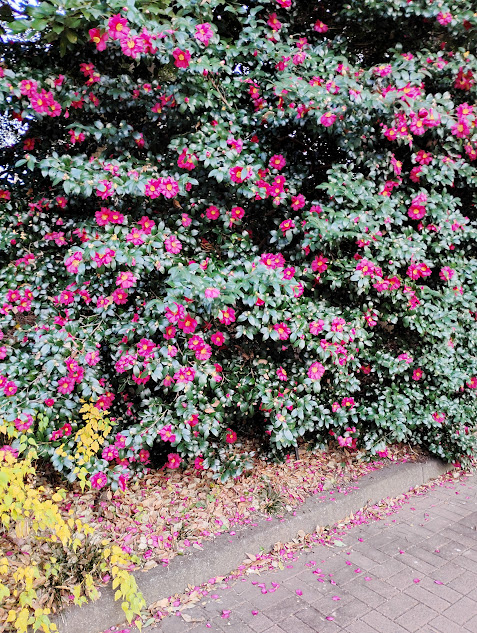
As winter arrives, Camellia sasanqua begins to bloom quietly and gracefully. At Jindai Botanical Garden, you can enjoy this elegant flower in various spots throughout the park. In this article, we’ll explore the history and characteristics of Camellia sasanqua, along with tips for deeper appreciation.
- A Conversation in the Garden
- What Is Camellia Sasanqua?
- How to Tell It Apart from Camellia Japonica
- The Delicate Beauty of the Petals
- Backgrounds That Highlight Sasanqua
- Contrast with Winter Landscapes
- How to Grow Camellia Sasanqua
- Key Tips Recap
- Sasanqua in Literature and Poetry
- Conclusion: Why Sasanqua Is the Flower of Winter
A Conversation in the Garden

I wonder if there’s anything fun to see at Jindai Botanical Garden even in winter, Grandpa AYA.

Of course, Fuku-nyan. Even in a winter garden, there’s a lot to enjoy.
The best way to enjoy Jindai Botanical Garden is to take a slow, relaxed walk. It’s like how we used to wander home from school—lingering here, swaying there, and heading home without a destination. Look at the clouds shifting over the Musashino Plateau, feel the wind in the trees, enjoy the quiet sunlight in the groves. Encounters with plants throughout the seasons happen best during a peaceful walk.
First, grab a garden brochure. It shows the number of steps to each major plant area. You can even mark your favorite plant spots and create your own custom garden map.
And if you plan to visit often, the annual pass is definitely worth it.
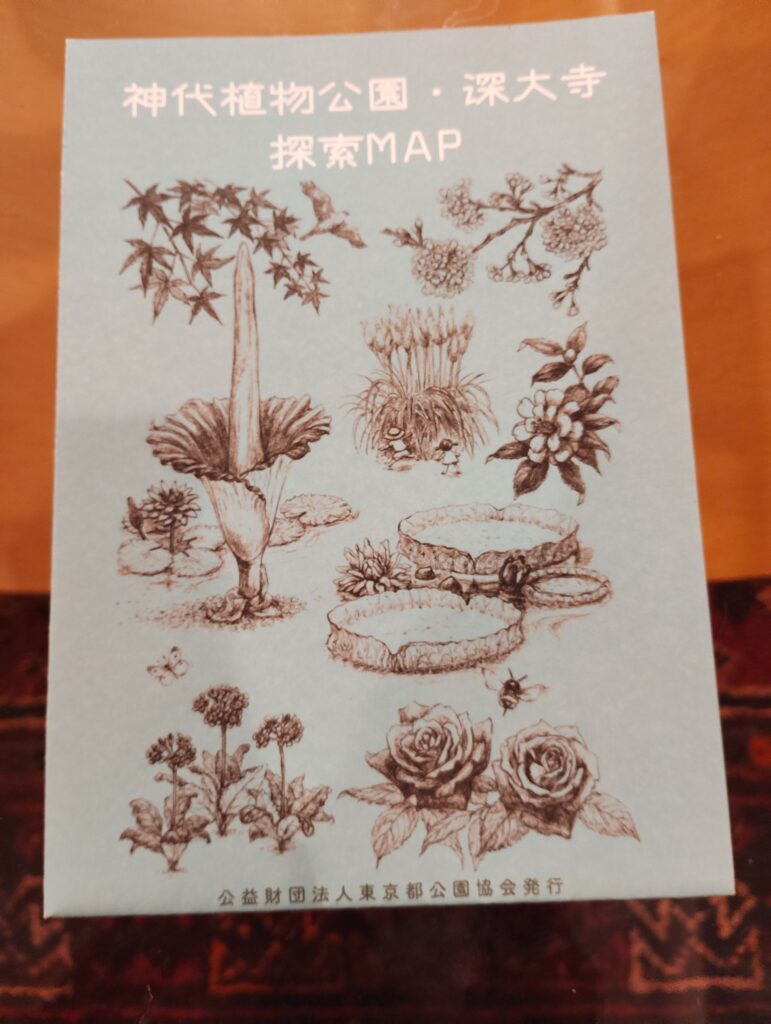
What Is Camellia Sasanqua?

In the cold months, you may have seen this lovely flower blooming in gardens and parks. Many people admire its beauty, but it’s often confused with Camellia japonica. What’s the difference?
Let’s look at the key traits of Camellia sasanqua:
- Blooming period: October to December (late autumn to early winter)
- Petal shedding: Petals fall one by one
- Flower shape: Slightly open, center often visible
- Leaf edge: Serrated
- Fragrance: Lightly sweet
Since it blooms during the colder months, Camellia sasanqua brings valuable color to winter landscapes. The way its petals fall one by one creates a delicate scene that blends beautifully with Japan’s winter surroundings.
How to Tell It Apart from Camellia Japonica
While they belong to the same family, the two flowers have several key differences:
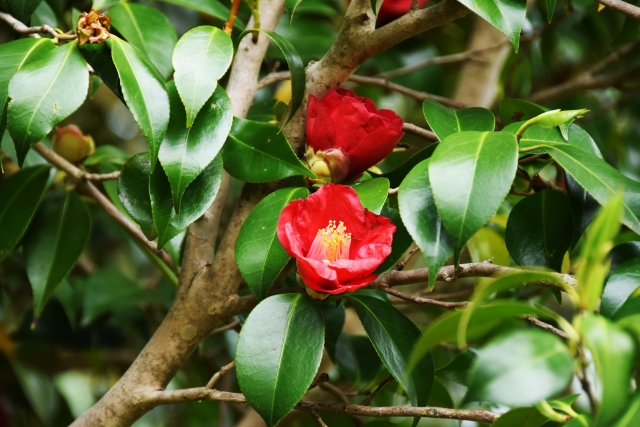
| Feature | Camellia Sasanqua | Camellia Japonica |
|---|---|---|
| Blooming Season | Oct–Dec | Dec–Apr |
| Petal Drop | One by one | Entire flower drops |
| Flower Shape | Open center | Round, closed center |
| Leaf Edge | Serrated | Smooth |
| Fragrance | Lightly sweet | Odorless |
The most obvious difference is how they fall. Sasanqua’s petals flutter down like snowflakes, while japonica flowers drop whole with a “plop.” Pay attention to the fallen petals next time you’re in a winter garden!
The Delicate Beauty of the Petals
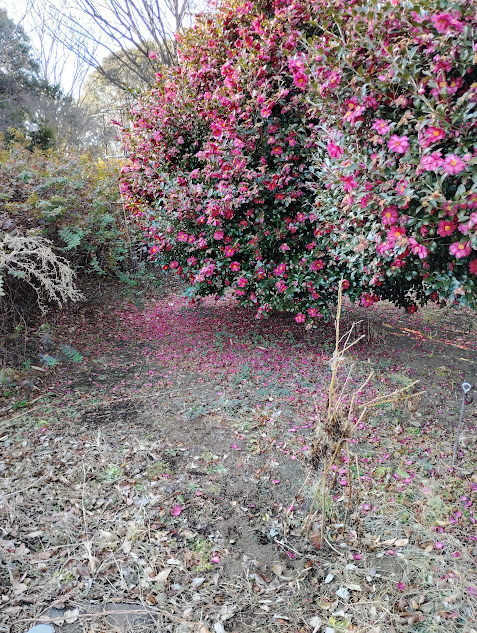
Compared to other winter flowers, sasanqua petals are thin and soft. Their fragility is part of their charm, especially when paired with the crisp winter air.
The way petals fall one by one brings a sense of quiet farewell. Unlike Camellia japonica’s bold drop, sasanqua expresses gentleness and emotion. Fallen petals scattered on the ground look like a pink or white winter carpet, especially magical when mixed with snow.
Backgrounds That Highlight Sasanqua
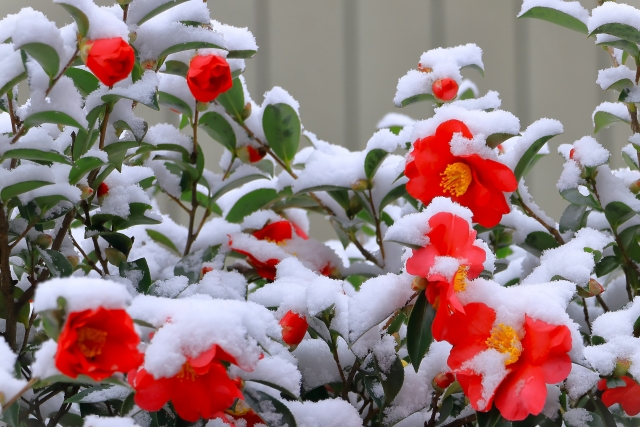
Camellia sasanqua blooms in the stillness of winter. Surrounded by leafless trees and faded colors, its flowers shine like lights warming the cold.
Some beautiful backgrounds include:
- Sasanqua against a snowy backdrop
- Fallen petals on green moss
- Traditional Japanese gardens and temple buildings
These combinations reflect Japanese aesthetics—quiet beauty in simplicity.
Contrast with Winter Landscapes
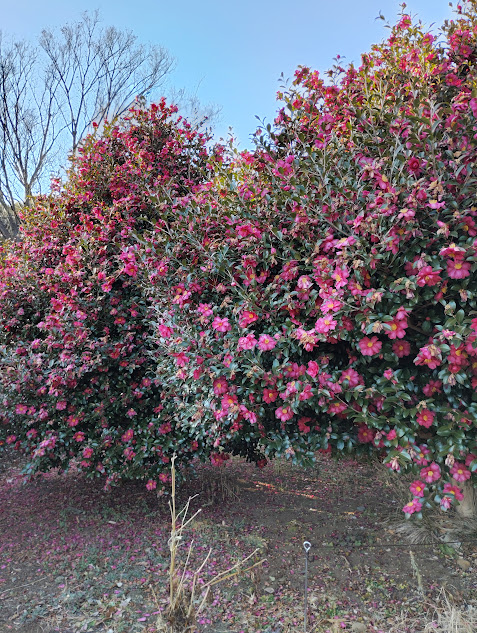
Winter tends to be colorless, but sasanqua adds vividness. It’s one of the few flowers that bloom boldly in the cold.
Highlights include:
- Snow-covered branches with blooming sasanqua
- Petals on white snow, creating soft patterns
- Sunlight on snow and flowers together
You’ll be reminded that winter also has its own kind of beauty.
Sasanqua comes in several shades:
- Pink – most classic
- Red – vibrant and striking
- White – ideal for snowy scenes
Because it blooms from December through January, it’s a great flower to add color to your winter garden.
How to Grow Camellia Sasanqua
Though beautiful, some people struggle to grow sasanqua. Here are beginner-friendly tips for success.
- Soil:
It prefers slightly acidic soil. Use azalea/camellia mix or blend akadama + kanuma + compost. If your soil is alkaline, mix in unadjusted peat moss. - Watering:
- Ground-planted: Rain is usually enough; water during dry spells
- Potted: Water thoroughly when surface dries
- Pruning:
Best done in March–April after blooming. Remove crossing, weak, or overgrown branches. Avoid heavy pruning in July–October as it reduces flower buds. - Pests:
Watch for tea tortrix moths from May to September. Remove affected leaves early. Use insect spray if needed. Wear gloves—these caterpillars cause skin irritation.
Key Tips Recap
- Use acidic soil
- Keep soil moderately moist
- Prune in early spring
- Protect against pests
Follow these, and you’ll enjoy healthy, blooming sasanqua even in winter.
Sasanqua in Literature and Poetry
Camellia sasanqua often appears in Japanese haiku and literature, symbolizing winter quietness and emotional subtlety.
Haiku examples:
“Sasanqua petals
fall gently in the rainy garden —
silence deepens.” – Takashi Matsumoto
“Sound of the wind –
sasanqua falling
without a sound.” – Kyoshi Takahama
These poems evoke the quiet grace of sasanqua petals falling like snow.
In Mori Ogai’s short story Sazanka, the flower symbolizes the fleeting nature of life. Akiko Yosano also wrote of sasanqua blooming with quiet strength in winter.
The name “Sazanka” was once pronounced “Sansaka.” Written as 山茶花 (“mountain tea flower”), it sometimes causes confusion with tea plants, but its kanji expresses a poetic elegance combining nature and grace.
Conclusion: Why Sasanqua Is the Flower of Winter
Camellia sasanqua quietly blooms in winter, shedding its petals like whispered farewells. It brings color, emotion, and subtle beauty to the season.
Let’s review what makes it special:
- Its contrast with snow and bare branches
- Its gentle way of falling
- Its poetic symbolism
- Its ability to bloom in your own garden
If you see sasanqua blooming this winter, take a moment to appreciate its quiet charm. You may find that the cold season feels just a little warmer.
📎 日本語で読む:
「神代植物園の冬を彩る山茶花の美しさとは?」
https://jindaijisaruku.com/sazanka/
